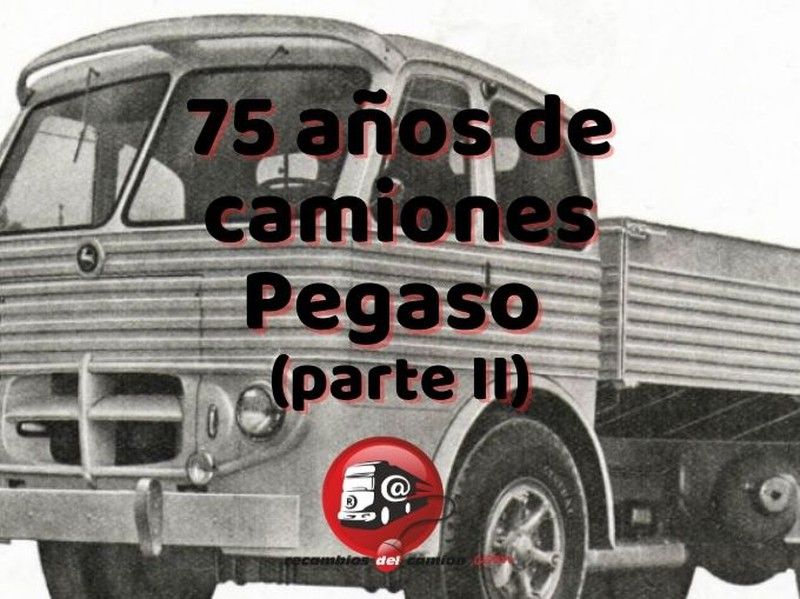75 years of Pegaso trucks (part II)
In this second article, in the previous one and in the next ones, we review the history of this great Spanish brand, dedicated to the manufacture of trucks, now that it is 75 years old.
You can retrieve the first part of the article HERE

While in Madrid they were creating the Z-207 Barajas, which we already told you about in the first part, the Barcelona factory was entrusted with the task of making changes to the Pegaso II. The Barcelona team clearly overstepped the mark by secretly creating a completely revamped truck incorporating many improvements, creating the Z-206.
They improved the cabin of the Z-206 and incorporated power steering, engine braking and made a new chassis with a payload of 8 tons. Also, they gave more power to the Z-202 engine for this model.
This total redesign, and done without the approval of the brand's management in Madrid, ensured that the Barcelona technical team was not dismissed and consolidated it as a great asset of the brand.
From the Pegaso Z-206 came various models of coaches (Z-408, Z-409, Z-410, Z-411, Z-412) and the Z-703 tractor unit.
The Z-207 was very technologically advanced, but it had a problem, it was expensive. The Barreiros models at that time cost half as much, and this forced the brand to make decisions in this regard.
To solve this competitive disadvantage, Pegaso presented the Pegaso Comet in 1964, replacing the original engine with a Leyland that Pegaso built under license and lowering the price of this model.
Although it had initial cooling problems, which were quickly resolved, the Comet was very successful.
His presentation was spectacular. On the day of its launch, 180 Pegaso Comet left the Madrid factory in Barajas together for the different dealers in the country.
The innovations of the Comet made it a very popular model and still remembered today. It highlighted its great capabilities, its reliability and its improvements in security. It was one of the first trucks to incorporate the electric brake, which, thanks to an electromagnet that braked the transmission thanks to the electromagnetic force. This made life much easier for the truck drivers of the time who, with the previous brakes, suffered when descending loaded mountain passes.
Until 1963 Pegaso had designed prototypes of military vehicles but could not sell trucks to the Spanish Army due to the restrictions of the Marshall Plan.
This American aid plan, conceived for the reconstruction of Europe after the Second World War, provided the country with a large amount of economic aid, but establishing conditions. The main one is that these aids could not be used to purchase products that were not manufactured in the United States.
These restrictions led the Army to an extreme situation, with an obsolete mobile fleet, with more than 300 different models, which came from the remains of the Second World War and the Korean War, for which it was practically impossible to get spare parts and therefore, many were out of service, providing parts to those who were active.
In 1963 the Army changed this by making a study of the models it needed and opening public tenders to cover those needs. Pegaso then wins the tender for the sale of a 4x4 truck model with a DAF engine and transmission, which were later replaced by the Comet engine, in its diesel version and the brand's own transmissions.
From 1964 Pegaso began to produce models with 3 and 4 axles, equipped with powerful 200 CV engines and later with turbocharger engines, reaching 260 CV of power.
With these engines, various tractor heads were also equipped, such as the popular 2011, which reached a maximum authorized weight of 38 tons.
Until 1966 the Valladolid-based company Sociedad Anónima de Vehiculos Automóviles (SAVA) was a competitor of Pegaso, producing some models of heavy trucks.
Enasa finished off this competitor by absorbing Sava and eliminating its heavy truck production lines, leaving only a few of Sava's van models, which a year later came under the Pegaso brand. This purchase was a first step for the creation in the early 90s of the well-known Daily, which we will talk about later.
Also in 1966, the Super Comet or Pegaso 1065 was launched, which took advantage of a new regulation that established the weight per axle. This model used the Comet cockpit, somewhat modified, hence its name. It reached a Maximum Admitted Weight of 18 tons.
Later, 19 and 20 ton PMA variants of the 1065 were produced. These were known as Europa, and were produced until 1977.
In 1972 Pegaso launches a new range to comply with European axle weight regulations with a squarer cabin than those of the Comet and Super Comet. Thus were born the 1080 models, with two axles, 1083, with three axles, 1086, with four axles and the 2-axle tractor unit, the 2080.
With these models, the new 12-liter engine is also introduced, adding engines of 230, 250, 310 and 352 CV to the current 170, 200 and 260 CV that continued to be produced.
Sources: Autofacil.es and Diariodetransporte.com





Opinions of our clients
Receive our news